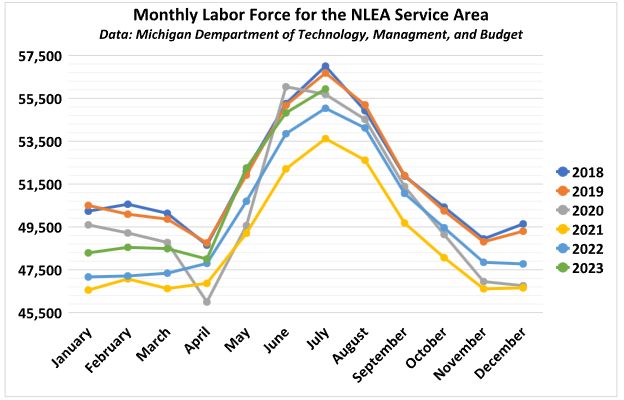Monthly labor force data shows the regional workforce is approaching pre-COVID levels. However, the region’s aging population poses a long term challenge.
By: Sam Bailey – Strategic Initiatives Manager, NLEA
There is good news and bad news when it comes to the regional workforce which has been a challenge in Northern Lower Michigan in recent years, especially following the COVID-19 pandemic. The good news is that recent data shows the local labor force is approaching pre-COVID levels. The bad news is that our long-term demographic trends point to a shrinking workforce in the future. Concerns regarding the state’s workforce have been elevated with the administration hiring a new Chief Growth Officer, establishing the Growing Michigan Together Council, and launching a talent attraction campaign. While these events are covered extensively in the news, it is important to understand the local trends.
Data released by the State of Michigan shows that the summer labor force in Antrim, Charlevoix, Cheboygan, and Emmet Counties is approaching pre-COVID levels as seen in Figure 1 below.

Figure 1 shows that four counties’ aggregate workforce in May and June of 2023 closely paralleled 2018 and 2019 before falling short of the pre-COVID summer peak. While the data for July is still preliminary, this growth trend is a positive for local businesses, governments, and nonprofits who have faced hiring challenges in recent years. A larger labor force means there are more workers to meet the needs of local employers. Table 1 reveals that the regional growth trend is also present in each of the counties the NLEA serves, with Antrim and Charlevoix Counties actually exceeding their pre-COVID labor force for the month of July.
| Table 1: July Workforce by County | |||
| 2019 Workforce | 2021 Workforce | 2023 Workforce* | |
| Antrim County | 11,504 | 10,983 | 11,530 |
| Charlevoix County | 14,253 | 13,508 | 14,282 |
| Cheboygan County | 11,452 | 10,982 | 11,402 |
| Emmet County | 19,473 | 18,145 | 18,724 |
| *July 2023 data is still preliminary Data is from the Michigan Department of Technology, Management, and Budget. | |||
There are number of factors pulling people into the workforce and keeping them out. Those who went back to school during the pandemic have been completing their degrees or programs and entering the workforce. Wages are rising which is a draw. Inflation is decreasing the value of retirement savings, potentially pushing older workers to take on part-time jobs. In contrast, childcare remains hard to find and expensive for those who can secure it. The health risks and stock market growth associated with the COVID-19 pandemic pushed many older workers out of the labor force a few years earlier than expected; a significant portion of these individuals are unlikely to return to the workplace as they have settled into retirement. While the recovering labor force is positive for the region, the future of the labor supply is not guaranteed.
Local stakeholders should be conscious that demographic trends point to a workforce that will continue to shrink. Table 2 shows that the population of each NLEA county is aging rapidly.
| Table 2: Changes in the Population 60+ Years Old | ||
| Share of Population in 2021 | Change since 2010 | |
| Antrim County | 37.7% | +9.7% |
| Charlevoix County | 34.2% | +10.4% |
| Cheboygan County | 37.2% | +9.5% |
| Emmet County | 30.2% | +7.8% |
| Data is from the US Census Bureau’s American Community Survey Five-Year Estimates. | ||
The fact that the NLEA service area aging faster than the state and country is a cause for concern. As the share of the population over the age of sixty grows, there are less working age individuals available to local employers and there is increased demand placed on certain industries, like healthcare. This age group’s growth is driven by how desirable the region is to live in; local retirees stay here and other retirees move here too. While the number of older residents is growing, the number of younger residents is shrinking. In the NLEA service area, there were 4,641 fewer individuals under the age of twenty in 2021 than in 2010. As this share of the population shrinks, there are less students to fill seasonal jobs and enter the local workforce after graduation. As the population of older residents grows and the population of younger residents declines, leaders must consider how to make the regional economy more resilient.
Demographic trends show that the next generation of the region’s workforce is not being raised here. This reality reveals the need for a regional talent attraction and retention strategy to ensure the continued success of the local economy. This summer, the NLEA launched Choose the North, a talent campaign aimed at highlighting the professional opportunities and quality of life Northern Lower Michigan has to offer. While the campaign’s social media reach continues to grow, it is just one part of the solution to a challenge that requires a multifaceted approach. Civic and business leaders must continue to develop tools and strategies to address regional labor force trends.







